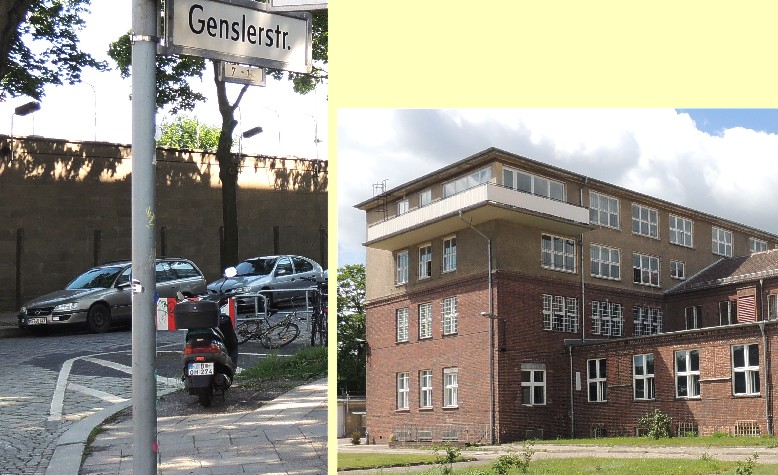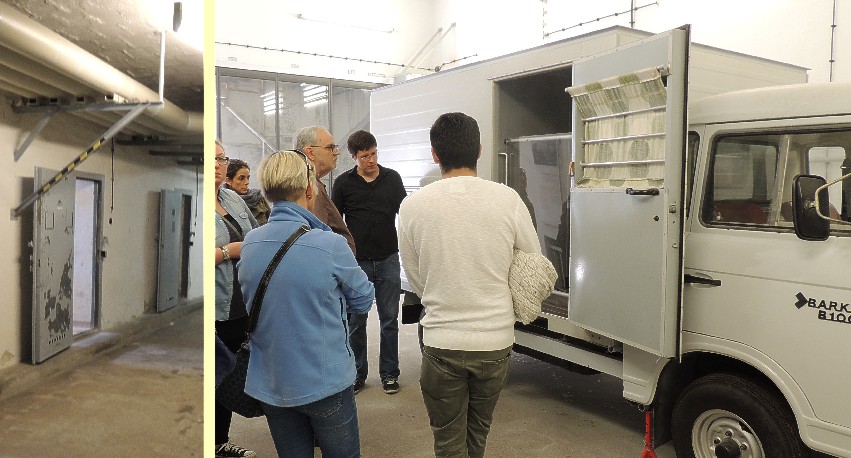Kansas Snapshots by Gloria Freeland - June 14, 2013
Gensler Strasse 66
"How far now?" husband Art asked.
"We're about a block away," daughter Mariya answered, glancing at the GPS.
Our slow progress along Gensler Strasse was only partially determined by our search for #66. The rough cobblestone streets of that
off-the-beaten-path section of northeast Berlin are narrow and parked automobiles make them even more so.
In most regards, the area appears to be just another urban residential neighborhood on the former East-German side of the city.
When the German Democratic Republic - Deutsche Democratische Republic (DDR) - dissolved almost 25 years ago, cookie-cutter apartment buildings
constructed of gray concrete occupied block after block. They remain, but in an effort to erase the drab world of yesteryear,
some have been painted green, yellow, salmon, orange or pink. Brightly-colored balcony panels have been added to others. A few are adorned with
paintings of trees, birds and various outdoor scenes. But for many neighborhoods, if it weren't for the green of the grass and trees, the
predominant color is still gray.
"This must be it," I said when we came to a tall gray cement wall stretching along much of an entire block.
It is called Hohenschoenhausen - "high pretty houses" - but we never learned the name's origin. The wall is broken only by a single monitored
entrance point, producing the feel of a prison. It also reminded me of police stations in Northern Ireland, where walls were needed to protect
those inside from the citizens outside. An official-looking sign indicated it was a government building.
In reality, the whole neighborhood had once served the purpose of Gensler Strasse 66 - a purpose, it could be argued, that represented the
East German state at its worst.
During World War II, the red-brick building at the center of the complex had served as a canteen for workers in Hitler's National Socialist
People's Welfare Organization. But after Soviet troops overran the area at the end of the war, it was transformed into a prison for anyone who
was deemed to be a threat. Prisoners were used to build rows of cells below the building. The complex was referred to as the
"submarine" because it was dark and dank. Each cell had two openings - the entrance door and a square vent hole a few inches wide on
the opposite wall. Each cell was equipped with a wooden bed and a bucket that served as a toilet. A single lamp above the doorway burned night
and day, erasing any sense of time. The poor air flow and the practice of housing multiple prisoners in a cell meant that moisture from
breath and sweat sometimes condensed and fell from he ceiling . One former prisoner recalled mold growing in her hair.
Interrogation was a physical affair. Former prisoners reported losing front teeth from blows from fists or bottles.
When the Soviet Union grew weary of directly managing the countries it had conquered, the era of puppet
governments began. When the DDR came into being, Hohenschoenhausen became a key component in its Ministry for State Security - the DDR's secret
police. The purpose of the prison, along with 17 subordinate facilities across the country, was to neutralize all threats to the state. Nearby
apartments served as residences for guards, interrogators and others who worked for the Stasi, as the agency came to be called,
while also providing a buffer between the prison and surrounding neighborhoods.
But operating the prison was only a small part of the Stasi's work. Threats could come from anywhere so many eyes and ears were needed. Eventually,
the Stasi emplyed 91,000 East Germans - more than 10 times the number in Hitler's feared Gestapo. The Stasi recruited nearly
200,000 citizens as collaborators. When the country collapsed, there were 4.2 million names in its files - about one for every four East
German citizens.
Suspects rarely knew they were under suspicion. Arrests generally came without warning at their work or at surprise early-morning visits to
their homes. The Stasi sometimes grabbed suspects as they walked along the street, stuffing them into vans marked as ordinary business vehicles.
Living in West Berlin did not guarantee safety from the Stasi's reach. Some outspoken critics were kidnapped and taken across the
border to a waiting Hohenschoenhausen cell.
In the 1950s, the DDR replaced the "submarine" with a new complex that had more than 200 cells and interrogation rooms. Physical coercion
gave way to psychological methods. Cells had translucent glass on an outside wall, so only a sense of light and dark passed through. Prisoners were
forced to sleep on their backs with both hands visible. During hourly checks, those not complying were awakened, leading to sleep deprivation.
Half of the cell mates and around 25 percent of prisoner lawyers were collaborators. Interrogations often lasted for hours with the prisoners
forced to maintain certain positions during the process. They might be told that unless they confessed, their children would be taken away or
other family members would be arrested. The whole process was intended to disorient and make prisoners believe they had to confess, guilty
or not.
Stephan led our tour of Gensler Strasse 66. He is a trained historian who was about 7 when the DDR dissolved. A booklet he carried was filled
with copies of a few of the more than 100 kilometers of Stasi files recovered after the DDR collapsed - an amount more than twice the sum of all
other DDR ministry documents. Born in West Germany, he has no direct memories of the DDR. His age, training and birthplace facilitate a
presentation devoid of judgment. As I looked at the members of our group, only one other couple appeared to be of my generation. For the others,
East Germany is something from before their time.
One of the tour members asked Stephan what became of the people who worked there. Art suggested they just blended into the post-unification
society - an answer Stephan quickly acknowledged. He said former prison administrators occasionally visit and sometimes bump into former
prisoners, some of whom now give guided tours of the facility. Stephan said one of the staff psychologists/interrogators now works as a school
psychologist. Many others are now retirees.
While this "blending in" provokes a certain sense of injustice, it arises partly from our perspective. When the Nazi state was destroyed, there
was an understandable backlash by the people it had suppressed. Some became true believers in the utopian goals of the DDR. Overzealous
practices in defense of their country were not so different from methods the United States employed during the 1950s McCarthy era when the
communist threat created panic. While there is a feeling of outrage over abductions of West Germans by the East German state, zealots
in our own government have recently performed similar acts, labeling them justifiable for the same reasons the East Germans gave.
When the American Civil War ended, President Abraham Lincoln was asked what to do with the Southern prisoners. He was reported to have said, "Let them up
easy," for they were Americans, too. When the DDR government fell and reunification of the two German states began, our friend Baerbel
and other former East German citizens were allowed to see their Stasi records. She obtained the application form, but then decided not to carry
through with it. She had lived through those difficult circumstances and decided she didn't want to know who among her neighbors and colleagues
might have reported on her. They were all just Germans again and that was enough.

